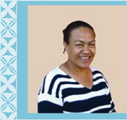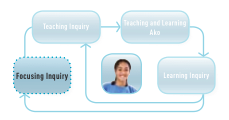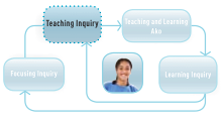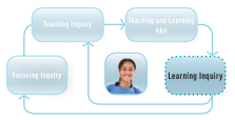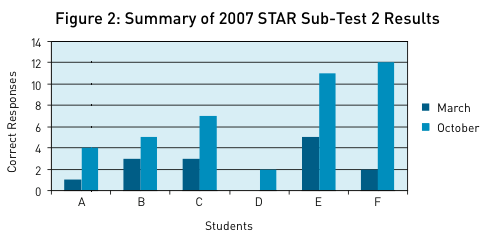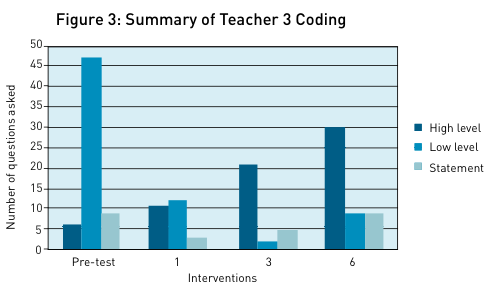Akata teaches year 7–8 students in a Samoan bilingual unit in a decile 1 intermediate school. Several of her colleagues were also engaged in inquiry, and two of her fellow bilingual teachers helped by coding the interactions between Akata and her students as recorded in video transcripts.
Akata’s inquiry question was:
What impact would the use of high-level questions in the Samoan language have on students’ understanding of texts written in English?
Akata’s focusing inquiry
What was important, given where Akata’s students were at?
Akata’s inquiry was motivated by her deep concern for her school’s Samoan students, whose levels of literacy in the English language were often not sufficient for them to readily access the school’s curriculum. The Samoan part of the title of her report vividly expresses this concern. Literally, “Tama ‘a le ‘ele‘ele, sa‘ili mālō” means “Child of the earth, freedom fighter”. To Akata, it means “Children of the land, fight for freedom!”
Akata was aware that many students in the Samoan bilingual unit were finding it difficult to read and understand English texts. Her own experiences and her reading of research literature led her to focus on how she could build more effectively on her students’ prior knowledge and cultural and linguistic resources by incorporating their first language in their literacy learning.
Akata’s target students were three boys and three girls, all but one of whom were born in Sāmoa. The students had very poor reading comprehension, as revealed in their Supplementary Test of Achievement in Reading (STAR) results. On the other hand, they were all fluent speakers of Samoan. Akata’s first priority was to try to help them deepen their thinking and questioning about the English texts they encountered.
What research evidence did Akata draw on?
Akata’s concern was prompted in part by a body of research showing that a disproportionate number of New Zealand students who are underachieving at school belong to cultural minorities. Many of these students are Pasifika. However, Akata took heart from research showing that:
Where bilingual students’ first language (L1) is valued, recognised, and used in the teaching and learning process, the educational success of bilingual students has been shown to improve, often markedly.
Ministry of Education, 2007, page 9
What evidence did Akata use from her own practice or that of her colleagues?
One of the tests Akata uses is STAR sub- test 2, which tests students’ sentence comprehension. In particular, it measures students’ decoding skills and their ability to use a range of sources to gain meaning. At the beginning of the year, Akata’s target students achieved an average mark of 2.3 out of 12 in this sub-test. This put them in stanine 1, meaning that their achievement was among the lowest 4 percent for all students in the same age group nationwide. (See the March results in Figure 2.)
Akata’s teaching inquiry
What strategies were most likely to help Akata’s students learn what they needed to learn?
Akata’s focusing inquiry had indicated a general direction for her intervention. In the teaching inquiry, Akata considered specific strategies for increasing her students’ understanding of English texts. She wondered whether a change in her style of questioning might have an impact on their reading comprehension. While the literature was equivocal about the impact of different ways of questioning, Akata thought that a shift to higher-level questions might better extend her students’ thinking.
Akata chose guided reading as the context for her inquiry because of its central role in the literacy programme. By questioning her students in Samoan rather than English, she hoped to increase the amount and quality of the students’ interactions with each other and their understanding of the texts.
Akata conducted her intervention in fifteen guided reading sessions that took place over five weeks. She decided that she would gather information from four key sources:
- STAR: STAR had already provided Akata with baseline data about her students’ achievement. She planned to use it again at the end of the year to measure any improvements in her target students’ reading comprehension.
- Video recordings of four guided reading lessons: Akata planned to analyse these after each lesson, using them to better understand her own questioning and her students’ responses. She decided to ask two colleagues to help her analyse transcripts of these recordings, coding them in relation to a “three-level guide” framework (see below).
- Student questionnaires: Akata developed a questionnaire to gather information about the students’ use of Samoan at home and their feelings about its use in the classroom. (See Figure 1.)
- Interviews with the target students: Akata planned interviews to allow the students to expand on their responses in the questionnaire and to express their feelings about the factors that influenced their achievement.
What research evidence did Akata draw on?
Effective Literacy Practice in Years 5 to 8 (Ministry of Education, 2006) was a key source for Akata. It describes questioning as one of the instructional strategies most used by teachers but warns about the importance of using questions deliberately with a clear learning goal in mind. It also explains that guided reading plays a central role in leading students towards independence in reading because “The focused small-group setting enables the teacher to give strategic instruction in making meaning from and thinking critically about increasingly complex texts” (page 104).
Akata also drew on Herber (1978), who developed “three-level guides” as a way of helping students think through the information in texts:
- Level one (literal): The student reads “on the lines” to work out what the writer is actually saying.
- Level two (interpretative): The student reads “between the lines” to interpret what the writer might mean.
- Level three (applied): The student reads “beyond the lines” to evaluate the information and relate it to other contexts.
Akata was encouraged by reading a doctoral thesis by Meaola Amituanai-Toloa (2005). This thesis reports on an intervention focused on raising the English reading comprehension of Samoan students. The intervention took place in six South Auckland bilingual classrooms over two years. Its findings suggest that “low achievement in English reading comprehension can be changed, but there is more research that needs to be done to expand our knowledge of how Pasifika students in schools comprehend English texts but specifically how they should be taught” (page iii).
What evidence did Akata use from her own practice or that of her colleagues?
Students’ responses to the questionnaire helped Akata to understand the context for her inquiry. Their use of Samoan at home varied. They tended to use Samoan when communicating with parents, grandparents, uncles, and aunts and on particular occasions, such as church, family meetings, and evening prayers. They used more English and less Samoan with their cousins or if one of their parents was not Samoan. The following contrasting comments reflect the students’ mixed feelings about the use of Samoan at school:
'I’m ashamed to talk in Samoan. Others tease me.'
'I like talking in Samoan to my mates.'
Figure 1: Collated responses to Student Questionnaire | Fa’amolemole tali mai fesili ‘o i lalo. (Please answer the questions below.)
|
| 1.
| ‘E te tautala fa’asāmoa ‘i le fale? (Do you talk Samoan at home?)
|
|
| ‘Ioe (Yes) (5)
| Lēai (No) (1)
|
|
|
|
| 2.
| ‘Āfai ‘e ‘ ioe, ‘o ā taimi ‘e te tautala fa’asāmoa ai? (If yes, when do you talk in Samoan?)
|
|
|
When communicating with parents and grandparents
During church, family meetings, evening prayers (especially during Bible reading and discussions)
|
| 3.
| ‘Āfai ‘e lēai, ‘aiseā? (If not, why not?)
|
|
| Dad is Pākehā – so most communicating is in English.
|
| 4.
| Lisi mai gagana ‘e tautatala ai lou ‘au’āiga? (List the languages your family members speak in.)
Ou mātua (Your parents): Samoan (5), English (1)
Ou uso ma tuagane po’o tuafāfine (Your brothers and sisters): English and Samoan
Isi tagata ‘e nonofo fa’atasi ma ‘oe (Other people living with you):
|
|
|
Grandparents: Samoan
Uncles and aunties: Samoan and a bit of English
Cousins: English and a bit of Samoan
|
| 5.
| ‘O le ā le telē ‘o le taimi ‘e te tautala fa’asāmoa ai ‘i le ā’oga? (What proportion of the time do you spend speaking in Samoan while in school?)
|
|
| a) 80–100%
| e) 60–79%
| i) 40–59% (5)
| o) 2–39% (1)
| u) 0–19%
|
| 6.
| ‘E te fiafia e fa’asāmoa ‘i le ā’oga? (Do you like speaking in Samoan at school?)
|
|
|
‘Ioe (Yes) I like talking in Samoan to my mates.
Lēai (No) I’m ashamed to talk in Samoan. Others tease me.
|
| 7.
| ‘Āfai ‘e ‘ ioe, ‘o ā taimi ‘e te fa’asāmoa ai? (If, yes when do you speak in Samoan?)
|
|
| During class; outside the classroom
|
| 8.
| ‘O ā ni fa’afītauli ‘o le tautala fa’asāmoa ‘o le faiāo’ga ‘i taimi ‘o le faitautusi? (What barriers are there when the teacher talks in Samoan during reading?)
|
|
|
It is hard for me to understand what you say sometimes. (1)
We understand the question, and we understand the English text, but it is hard to translate the answers in our
head. Samoan question, English text, it is not easy. (3)
|
| 9.
|
‘O le ā le taimi ‘e te iloa ‘e tatau ‘ona tautala fa’asāmoa ai le faiā’oga? (When do you recommend for the teacher to
talk in Samoan?)
|
|
|
During cultural activities only (1)
Outside the classroom (2)
When reading Samoan texts only. It is not easy trying to translate your Samoan questions and finding the answer
in English. Teach in Samoan when Samoan stories are used. (3)
|
|
| Fa’afetai mō lou taimi. (Thank you for your time.)
|
Akata’s learning inquiry
What happened as a result of Akata’s teaching, and what are the implications for her future teaching?
When Akata re-administered STAR at the end of her inquiry, she found a significant improvement in the student’s results. Akata used the rest of her data to better understand the relationship between her changed teaching practices and the students’ learning. She analysed her data in relation to three sub-questions.
- Did the use of the Samoan language help the students engage more in guided reading?
The video recordings showed increased interaction between Akata and the students and amongst the students. This interaction was focused on learning, with the students helping each other with their pronunciation and even helping Akata translate some of the English into Samoan. The students incorporated Samoan into their responses, which ranged from single words and phrases to complete sentences.
2. Did the use of Samoan in guided reading help students understand the English texts?
Analysis of the transcripts suggested that the students did understand the texts.
'The discussions they had amongst themselves showed the application of prior knowledge (… ‘e lē ta’a se malie ‘i se dairy, e ta’a’ i le sami / a shark does not hang around a dairy, it lives in the sea). Students were seen personalising their learning (… ‘ana o a’u lenā,’ ou te matuā alu ‘i le ‘ātoa / if that was me, I would have run as fast as I could) and linking discussions to their own experiences. The students showed competence in understanding, using, and communicating in the Samoan language (… ‘e mafai ‘ona puipuia le tūlaga lea pe ‘ā fai se pā piliki maualuga e tāofi ai tagata leaga / they can prevent such things from happening again if they put up a high brick wall to stop these bad people), even though sometimes they tended to code switch (… e’ tu’u fo’i le sharp uaea i le pā / can also put sharp wires in the fence).'
3. What was the level of the questions the teacher asked during guided reading?
The coding by Akata and her two colleagues showed a steady increase in the percentage of high-level questions asked by Akata. She reported that:
Overall, 52 percent of the total number of teacher oral communications (questions and statements) during guided reading were of high level. 31 percent were of low level, and only 17 percent were statements.
Akata felt that:
Translating questions from English to Samoan seemed to change the tone and meaning of the questions, which resulted in the high number of statements and low-level questions, especially in the first lesson.
A number of issues, puzzles, and contradictions emerged from Akata’s inquiry, for example:
- Video analysis revealed that practices Akata thought were supportive could actually undermine her students’ learning. For example, she saw that she was good at building on and elaborating the students’ answers, but at times she talked too much and did not allow enough wait time. She needed to be more patient and not rush.
- Akata and her colleagues had quite different notions about what made for a high-level question, a low-level question, or a statement. This led to inconsistencies in their coding, though the general pattern of a shift to higher-level questions over time was the same.
- Despite the improvement they achieved, the students themselves still tended to think that Samoan should only be used with Samoan texts.
When reading Samoan texts only. It is not easy trying to translate your Samoan questions and find the answer in English. It is hard. Teach in Samoan when Samoan stories are used.
- Akata’s biggest puzzle was the effect of language on the questions. Questions that were short and snappy in English tended to become longer in Samoan. Consequently, Akata quite often found that she had lost the students’ attention by the time she’d finished asking her question.
The Samoan language is mild, polite, and euphemistic. This was a huge learning experience. I hadn’t realised what a big issue this was.
Perhaps Akata’s deepest learning came from her understanding of the need to address issues and dilemmas, such as the above, while maintaining a constant focus on improving outcomes for her students:
Teachers need to be honest with themselves … ask, seek, change. We must get to the heart of the issue. When a teacher teaches, they analyse data, then plan, but often teachers go off plan and don’t teach to the students’ needs and what they want to target. We need to be very conscious about how we go about implementing our plans. Too often, we get distracted by other things. Of course, the process of implementing the plan is not straightforward. We say we need to be flexible, but we can be too flexible and do things that aren’t focused on student needs. There are no cameras in the classroom – we can do what we like! We must be honest and admit when we need some help. Our foremost commitment must be to our students. I’m trying to get to the essence of what the students really need. We’ve got to get to it!
What research evidence did Akata draw on?
Akata drew on a body of research that is summarised in LEAP: Language Enhancing the Achievement of Pasifika, a professional learning resource developed for New Zealand teachers at all school levels who work with bilingual Pasifika students. LEAP is supplemented by an extensive literature review (PDF, 562.39KB) (Franken, May, and McComish, 2005) that provides valuable insights for all New Zealand teachers of bilingual Pasifika students.
What evidence did Akata use from her own practice or that of her colleagues?
Akata retested her students at the end of the year. Figure 2 shows the shifts in the students’ results in the STAR sub-test 2 from March to October. Their average score in October was 6.8 out of 12, three times their score in March.
Throughout the inquiry, Akata made it a priority to understand her students’ thoughts and feelings. Some of what she found was contradictory; for example, despite the shifts, one student thought the use of Samoan had actually made her comprehension of English texts more difficult:
because it is not easy … we read in English, listen to the Samoan language, and it is hard to translate.
Interviews with the students towards the end of the inquiry revealed the following:
- They liked it when Akata questioned them in Samoan.
- They liked working in both languages so that they know both the English and Samoan “faces” of the words.
- Some of them felt that it is inappropriate for the teacher to be teaching reading using Samoan, as the other students don’t learn in this way.
Akata graphed her own and her colleagues coding of her questions. Figure 3 summarises her own coding.
Analysis of the videos provided Akata with greater insight into her own practice and its impact on her students. She was quite shocked by what was
revealed when she moved on too quickly from one student to another:
The way her face changed – her face dropped. She was obviously thinking about the question and about to give an answer. That really woke me up. I thought it was okay because I was going to come back, and that I was soothing her; but she was really trying, and I was rushing.
What happened next?
Akata has continued her inquiry by looking at the effect of language on questions. She has developed a new style of questioning: instead of moving straight through a series of questions at different levels, she is providing more scaffolding for students and building stronger connections between the different levels.
It works! The students’ responses have changed. They’re able to give me the deeper answers I expect.
Recent STAR and asTTle data indicate continued substantial improvement. For example, in the following year, the students in her class gained on average three sub-levels in asTTle reading.
Akata is committed to ongoing learning. She has now completed her Master of Education degree, which included research into the challenges of supporting literacy in low-decile schools. She is continuing to look at what will make a difference for Samoan students and how she can capitalise on their language.
I think the bottom line is that I am more conscious of the choices I make during my teaching and the effect of such choices on students’ achievement. The more work I put in, the better the students’ achievement and the more I work again to get similar pleasing results.
Reflective questions
What questions does this story raise for you and your colleagues about:
- your school’s philosophy about and approaches to bilingual teaching?
- the degree to which you use your bilingual students’ first language as a platform for learning?
- the pedagogical practices that are effective in raising achievement for bilingual students?
- the different roles that questioning can play in extending students’ thinking?
- the levels of questions you use with your students?
- whether bilingual students at your school see their first language as an asset or a problem and why this might be so?
- the degree to which meaning can be transferred across different languages?
References
Amituanai-Toloa, M. (2005). Ua Mālie Toa ‘Ua Mālie Tau: Students with Silver Tongues Whip the Tail: Enhanced Teaching and Learning of Reading Comprehension in Samoan Bilingual Classes. Unpublished doctoral thesis, University of Auckland.
Franken, M., May, S., and McComish, J. (2005). Pasifika Languages Research and Guidelines Project: Literature Review.(PDF, 562.39KB) Hamilton: Wilf Malcolm Institute of Educational Research, University of Waikato.
Herber, H. (1978). Teaching Reading in the Content Areas. 2nd ed. Englewood Cliffs, NJ: Prentice Hall.
Ministry of Education (2006). Effective Literacy Practice in Years 5 to 8. Wellington: Learning Media.
Ministry of Education (2007). LEAP: Language Enhancing the Achievement of Pasifika. Wellington: Learning Media.
STAR Supplementary Test of Achievement in Reading Years 3, 4–6, and 7–9.
Published on: 26 Aug 2009
Return to top

